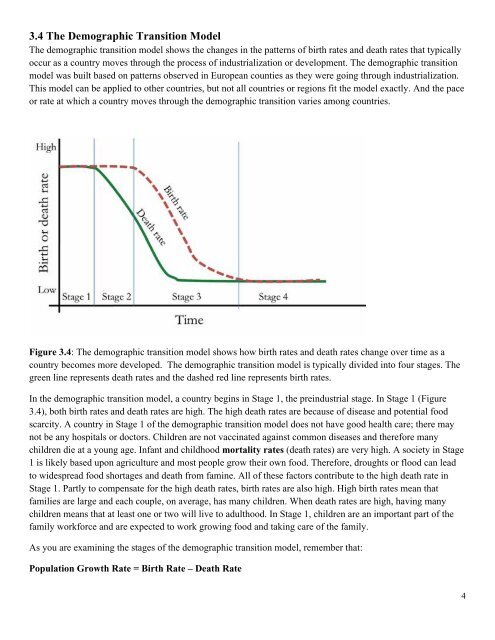Introduction to Environmental Science, 2nd Edition, 2018a
Introduction to Environmental Science, 2nd Edition, 2018a
Introduction to Environmental Science, 2nd Edition, 2018a
You also want an ePaper? Increase the reach of your titles
YUMPU automatically turns print PDFs into web optimized ePapers that Google loves.
3.4 The Demographic Transition Model<br />
The demographic transition model shows the changes in the patterns of birth rates and death rates that typically<br />
occur as a country moves through the process of industrialization or development. The demographic transition<br />
model was built based on patterns observed in European counties as they were going through industrialization.<br />
This model can be applied <strong>to</strong> other countries, but not all countries or regions fit the model exactly. And the pace<br />
or rate at which a country moves through the demographic transition varies among countries.<br />
Figure 3.4: The demographic transition model shows how birth rates and death rates change over time as a<br />
country becomes more developed. The demographic transition model is typically divided in<strong>to</strong> four stages. The<br />
green line represents death rates and the dashed red line represents birth rates.<br />
In the demographic transition model, a country begins in Stage 1, the preindustrial stage. In Stage 1 (Figure<br />
3.4), both birth rates and death rates are high. The high death rates are because of disease and potential food<br />
scarcity. A country in Stage 1 of the demographic transition model does not have good health care; there may<br />
not be any hospitals or doc<strong>to</strong>rs. Children are not vaccinated against common diseases and therefore many<br />
children die at a young age. Infant and childhood mortality rates (death rates) are very high. A society in Stage<br />
1 is likely based upon agriculture and most people grow their own food. Therefore, droughts or flood can lead<br />
<strong>to</strong> widespread food shortages and death from famine. All of these fac<strong>to</strong>rs contribute <strong>to</strong> the high death rate in<br />
Stage 1. Partly <strong>to</strong> compensate for the high death rates, birth rates are also high. High birth rates mean that<br />
families are large and each couple, on average, has many children. When death rates are high, having many<br />
children means that at least one or two will live <strong>to</strong> adulthood. In Stage 1, children are an important part of the<br />
family workforce and are expected <strong>to</strong> work growing food and taking care of the family.<br />
As you are examining the stages of the demographic transition model, remember that:<br />
Population Growth Rate = Birth Rate – Death Rate<br />
4


















